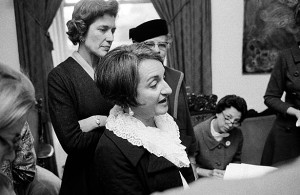50 Years of The Feminine Mystique

This week’s 50th anniversary of the publication of Betty Friedan’s ground-breaking work The Feminine Mystique has generated lots of commentary. Here’s a sampling.
The Skeptical Early Reviews of Betty Friedan’s ‘The Feminine Mystique’
In truth, The Feminine Mystique‘s 50-year shelf life got off to a somewhat rocky start. While many book critics immediately recognized the potential in Friedan’s book when it was released in 1963, some remained skeptical. Some detractors said it was too alarmist, others said it was too complacent—and one even complained that Friedan went too far in asserting that average girl wouldn’t rather be at home putting cream on her face. That last guy probably has a few regrets.
As these examples illustrate, pioneering work is usually recognized only in retrospect.
‘Anger Boiled Up, and Betty Friedan Was There’: ‘Feminine Mystique’ at 50
Betty Friedan’s The Feminine Mystique, which turns 50 next month, transformed the lives of women across America. In the early ’60s, Friedan, a self-identified homemaker, interviewed fellow Smith graduates for an alumni survey. She noticed an alarming pattern of dissatisfaction. Despite the fact that many of these women had achieved the domestic life they’d wished for—a home in the suburbs complete with modern appliances, children, and a bread-winning husband—they were miserable. It was a “silent problem,” Friedan wrote. “Why should women accept this picture of a half-life, instead of a share in the whole of human destiny?”
In this opinion piece in The New York Times Stephanie Coontz argues that The Feminine Mystique “had the impact it did because it focused on transforming women’s personal consciousness”:
Friedan set out to transform the attitudes of women. Arguing that “the personal is political,” feminists urged women to challenge the assumption, at work and at home, that women should always be the ones who make the coffee, watch over the children, pick up after men and serve the meals.
Over the next 30 years this emphasis on equalizing gender roles at home as well as at work produced a revolutionary transformation in Americans’ attitudes.
Why ‘The Feminine Mystique’ is Still Worth Reading in 2013
Nanette Fondas asserts:
Today, reading this classic feels like sitting down for a long talk with your wise, feminist grandmother to learn her generation’s ideas on how to compose a life that’s meaningful and fruitful. But revisiting the book to understand what Friedan was saying—what exactly she meant by a “feminine mystique”—reveals a logical and passionate argument that’s still relevant today: All people, including women with children, deserve to pursue work that helps fulfill their human potential.
